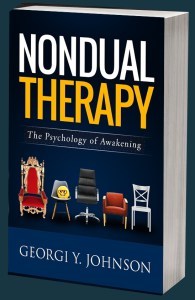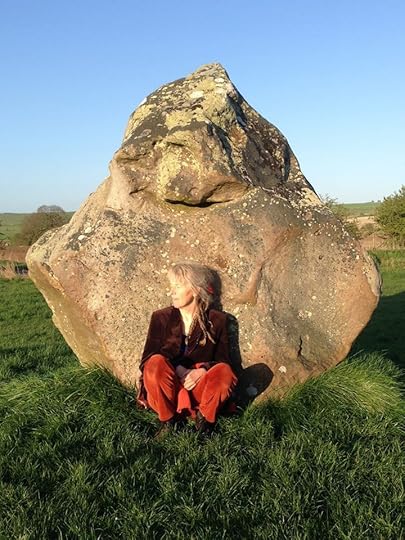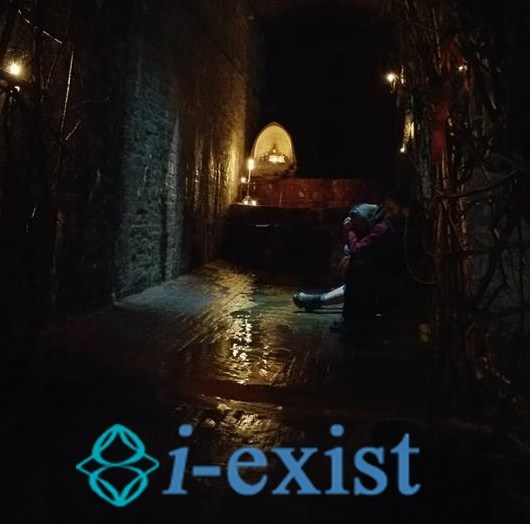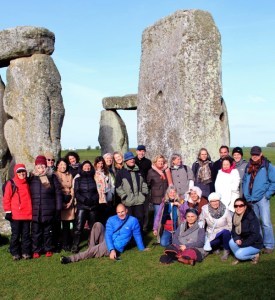Georgi Y. Johnson's Blog: I AM HERE - Opening the Windows of Life & Beauty, page 12
March 1, 2018
Song of the Soul: Khalil Gibran
In the depth of my soul there is a wordless song
A song that lives in the seed of my heart.
It refuses to melt with ink on parchment;
It engulfs my affection in a transparent cloak
And flows but not upon my lips.
How can I sigh it?
I fear it may mingle with earthly ether;
To whom shall I sing it?
It dwells in the house of my soul,
In fear of harsh ears.
When I look into my inner eyes I see the shadow of its shadow;
When I touch my fingertips I feel its vibrations.
The deeds of my hands heed its presence as a lake
must reflect the glittering stars;
My tears reveal it, as bright drops of dew reveal
the secret of a withering rose.
It is a song composed by contemplation,
And published by silence,
And shunned by clamour,
And folded by truth,
And repeated by dreams,
And understood by love,
And hidden by awakening,
And sung by the soul.
It is the song of love;
What Cain or Esau could sing it?
It is more fragrant than jasmine;
What voice could enslave it?
It is heartbound, as a virgin’s secret;
What string could quiver it?
Who dares unite the roar of the sea
And the singing of the nightingale?
Who dares compare the shrieking tempest
To the sigh of an infant?
Who dares speak aloud the words
Intended for the heart to speak?
What human dares sing in voice
The song of God?
~ Kahlil Gibran
February 24, 2018
Resource: Generational, Inherited Trauma & Epigenetics – Science, Articles and Ancient Wisdom
In the Media
I AM HERE archive on Inherited Trauma from the perspective of Nondual Therapy
It Didn’t Start With You: The Mystery of Inherited Trauma, Psychology Today
Childhood trauma can be inherited by future generations – new study. The Telegraph
The Bad News: Trauma Can Be Inherited. The Good News — So Can Resilience: Big Think
Traces of Genetic Trauma Can Be Tweaked, Scientific American
Breaking the Cycle of Inherited Family Trauma: Uplift Connect
Hereditary trauma: Inheritance of traumas and how they may be mediated, Science Daily
Trauma From Slavery Can Actually Be Passed Down Through Your Genes
How Inherited Family Trauma Shapes Us, Psyche Central
Inherited Epigenetic and Behavioral Consequences of Trauma Could be Reversed: What is Epigenetics
Selected Scientific Papers
2013
Fearful memories haunt mouse descendants
Nature
Epigenetic transmission of Holocaust trauma: can nightmares be inherited?
PubMed
2014
Implication of sperm RNAs in transgenerational inheritance of the effects of early trauma in mice
Nature Neuroscience
How Traumatic Experiences Leave Their Signature on the Genome: An Overview of Epigenetic Pathways in PTSD
Frontiers in Psychiatry
2016
The Great Migration and African-American Genomic Diversity
PLOS Genetics
Holocaust Exposure Induced Intergenerational Effects on FKBP5 Methylation
Biological Psychiatry
Biological mechanism passes on long-term epigenetic ‘memories’
2017
Transgenerational transmission of environmental information in C. elegans
Science
“The parents eat sour grapes, and the children’s teeth are set on edge.”
—Ezekiel 18: 2 (New International Version)
“Atrocities . . . refuse to be buried. . . . Folk wisdom is filled with ghosts who refuse to rest in their graves until their stories are told.”
—Judith Herman, Trauma and Recovery
“I feel very strongly that I am under the influence of things or questions which were left incomplete and unanswered by my parents and grandparents and more distant ancestors. It often seems as if there were an impersonal karma within a family, which is passed on from parents to children. It has always seemed to me that I had to . . . complete, or perhaps continue, things which previous ages had left unfinished.”
—Carl Jung, Memories, Dreams, Reflections
“If you look deeply into the palm of your hand, you will see your parents and all generations of your ancestors. All of them are alive in this moment. Each is present in your body. You are the continuation of each of these people.”
—Thich Nhat Hanh, A Lifetime of Peace
Questions for inquiry into family trauma
Courtesy of Mark Wolynn, from his book: It didn’t start with you* (Quotes above also courtesy of this powerful healing manual)
Who died early?
Who left?
Who was abandoned, isolated, or excluded from the family?
Who was adopted or who gave a child up for adoption?
Who died in childbirth?
Who had a stillbirth, miscarriage, or abortion?
Who committed suicide?
Who committed a crime or experienced a significant trauma?
Who suffered in war?
Who died in or participated in a genocide or the Holocaust?
Who was murdered?
Who murdered someone or felt responsible for someone’s death or misfortune?
Who profited from another’s loss?
Who was wrongly accused?
Who was jailed or institutionalized?
Who had a physical, emotional, or mental disability?
Which parent or grandparent had a significant relationship prior to getting married, and what happened?
*Wolynn, Mark. It Didn’t Start with You: How Inherited Family Trauma Shapes Who We Are and How to End the Cycle (p. 221). Penguin Publishing Group. Kindle Edition.
February 23, 2018
The Dance of Illegitimacy & Injustice in Nondual Therapy
The partner of illegitimacy is injustice.
Esteem has no opposite.
In Esteem, injustice and illegitimacy are one.
“I wish I could show you, when you are lonely or in darkness, the astonishing light of your own being.”
Hafiz
Everything we know is based on what we have experienced and all that we experience are phenomenon arising within a boundless field of awareness. Within this field, both the objects of perception and the space between them are alive with awareness. This means that the entire universe is both alive and aware. When forms arise through awareness, they are affirmed, appreciated and unchallenged in their existential, value. Spontaneously arising out of awareness is the subtle Nondual fluid of esteem. The sense of esteem is found in the reunion of consciousness with itself, or life with life, or the miracle of being here in a physical body with the miracle or perception.
 Esteem is a powerful, expansive energy of manifestation that is here in all we are, in whatever form, because we are. Esteem is in the trees, the mountains and the rivers. It is in the intelligent passage of a protein within a cell, and in the rising and falling of the tides. It is irrefutable. Yet in negotiating splits in the psyche between inner and outer, self and other, our bodies and nature, our individual manifestation and the True Nature of the whole, our unconditional sense of esteem gets obscured.
Esteem is a powerful, expansive energy of manifestation that is here in all we are, in whatever form, because we are. Esteem is in the trees, the mountains and the rivers. It is in the intelligent passage of a protein within a cell, and in the rising and falling of the tides. It is irrefutable. Yet in negotiating splits in the psyche between inner and outer, self and other, our bodies and nature, our individual manifestation and the True Nature of the whole, our unconditional sense of esteem gets obscured.
Contractions around esteem and self-esteem surface wherever forms of the Separate Self break down. Out of esteem, there is a passion to manifest. We feel special, unique and have a sense that our time here is a precious opportunity. Something momentous can seem to be at stake. Many forms of contraction are based on the evolution of the individual within the whole. In this, individuation cannot be forgotten. Yet there is a stage of individuation where individuality seems to be inseparable from limitation. Out of this limitation, we seek to become better, leading to further investment in the absolute form of identity and personality, and inevitably to despair. The paradox is that at Source, it is true that we are all individual, unique, precious and miraculous manifestations of the whole. We are unique, and it is our deeper purpose to manifest that individuality on earth. This is where esteem becomes thwarted, because the outer world can seem to reject our unique individuality, and that rejection gets internalized. The evolution is in the experience that we are miraculous, unique yet interdependent manifestations of one True Nature – or in the famous lyrics of U2: “We are one but we’re not the same. We get to carry each other…”

This is one of 35 energetic contractions in the psyche detailed in the book Nondual Therapy: The Psychology of Awakening.
Believing in the authority and judgements of conditioning, blocks around esteem show up as the suffering of illegitimacy and the rage at injustice. These feelings of severe devaluation within the greater whole contract our experience to the parameters of that same conditioning which has enslaved us: the beliefs in the verdicts of judgmental mind and as the invincibility of the Separate Self. When we become truly responsible for our own experience, we find the throne of esteem deep inside ourselves. As a rehab professional told an alcoholic client: “You’re the driver of your own life. Don’t let anyone steal your seat.”
Esteem is a spontaneous Source affirmation of form, as form. This includes flowing forms of expression, manifestation and receptivity. It is inherent to consciousness where there is no agenda of judgement. What has been called self-esteem is the same movement within the psyche. We never lack self-esteem, we simply experience contractions around esteem which are created by forms which are not affirmed in conscious awareness – where form is denied. Often, these contractions are internalized mechanisms arising out of rejections from outer authorities. For example, the social field of the playground, where the group bullies one child, contractions in esteem could affect that child for years. Paradoxically, the bullying behavior was probably generated by contractions in esteem within the bullies.
Illegitimacy
Hollowing out and disempowering the experience of form, the pain of illegitimacy has the power to create substrata of the psyche that resonate with inherent fault, untouchability and a subtle loathing that has a depth that causes us to believe that this vile stuff is what we truly are. This secret sense of the ‘Despicable Me’ surfaces as thoughts telling us that we have no authentic right to manifest and even that our manifestation is hurtful or dangerous to others. Through the suffering of illegitimacy, we can literally experience ourselves as toxic.
Born from the lack of acceptance, affirmation and honor from the ‘outside’ world, the horror of illegitimacy (not being worthy of taking space, here and now), gets internalized and buried between layers of pretense. No amount of certification, legitimization or public applause can alleviate this energetic discharge at the core of the psyche. In fact, it can even make it worse as it seems to inflate the lie.
We are all manifold expressions of illegitimacy. We have the wrong body weight; we’re the wrong gender for the job we take; we are the children of parents that divorced or died; we were born into the wrong class; or we are of the wrong color or religious faith. Reasons for the shock of illegitimacy abound, with goal posts of legitimacy shifting according to perspective. The inner wound in the psyche tends to attract experiences of illegitimacy, particularly noticing where others suffer, which feeds the threat of exclusion from the whole.
Injustice
Illegitimacy lacks reason and can be perceived as deeply unfair. In this, a rage arises towards the outer world as being inherently flawed and illegitimate in its authority. There is trauma here, as both illegitimacy and injustice have been experienced as survival threats and as causal players in poverty.
This is the rage at injustice. Arising out of the stinging pain of shame and social rejection, the pain of injustice seeks to restore balance through correcting the outer world. This can be destructive and fruitless as it reaffirms the belief in the inherent wrongness of form, birthing ever increasing examples of injustice in the field of perception.
The suffering of injustice awakens other contractions, with emotions of anger, jealousy and hatred. Yet the scream of “It’s not fair!” always depends on a forced kind of equality under certain conditions: for example, that children in a family should get identical presents on their birthday. The feeling of ‘not fair’, precedes the objective situation where fairness is demanded. Yet living parameters shift all the time. Could it be unfair that the mother hugged one child longer than the other? Later, that the other got a longer story at bed-time? In their quest for justice, children exemplify a deep human need for living affirmation in form which is deeply linked to the Nondual Quality of Esteem.
Esteem: Nondual Quality
 When we lack esteem, it can feel like we have nowhere to sit inside ourselves. It can be like going into an assembly where everyone is seated, and there’s no place for us. We stand to the side, as if invisible, as if we have no right to exist yet we exist anyway. We can feel like a ghost, haunting the lives of others. Insights into the destructive and incapacitating effect of a lack of self-esteem abound in the world of therapy. Yet few have gone deeper to inquire into esteem, with the shackles of belief systems in the Separate Self.
When we lack esteem, it can feel like we have nowhere to sit inside ourselves. It can be like going into an assembly where everyone is seated, and there’s no place for us. We stand to the side, as if invisible, as if we have no right to exist yet we exist anyway. We can feel like a ghost, haunting the lives of others. Insights into the destructive and incapacitating effect of a lack of self-esteem abound in the world of therapy. Yet few have gone deeper to inquire into esteem, with the shackles of belief systems in the Separate Self.
What is esteem? How does it feel as it arises through the cells, blood and bones of our physical manifestation? How does it affect the energetic fabric of contraction? In its purity, esteem can feel omnipotent. Esteem is the healing kiss of consciousness to form. It has the feeling energy of the biblical creation in Genesis, when God “saw that it was good.” Unconditional, the Nondual Quality of esteem gives an instant sense of legitimacy, power and reward. It’s a source of infinite expansion that can include any contraction. It enlivens without grasping; nurtures without control; and releases without attachment.
If it’s hard to get a sense of esteem on the inside, then we can ponder it around us. It is important not to be misled by appearances of pretended confidence and the broadcasting of status. Try connecting to the esteem of a horse as it gallops in freedom, or of a tree with branch tips stretching towards the sun, or of the sun itself, shining choicelessly and unconditionally and regardless of reflection. When esteem for what we are through all manifestation arises, it is stronger than any limitation of form, yet it blesses and affirms all forms in their temporal magnificence. It perpetuates inherent worth and expands the flow of energy through the psyche, turning problems to opportunities.
Esteem affirms all form as itself, as an energetic source more powerful than any transient judgement. Just as esteem rises through us, releasing the forms of the individual psyche into life, so does it naturally express through an esteem towards others, without compromise.
Contemplations
Recall a situation that you felt to be unfair, and stay with that sense of injustice, letting it expand where it wants to go. Find a space in the body where the sense of injustice is less, and invite it to support the area of affliction. If all experience carries the sense of injustice, then invite the support of a neutral power, such as an ocean, or the sun.
Move attention to the basis of body (pelvic area). Let consciousness affirm whatever appears in sense perception. You can use the words: “Also this is here.” Still at the basis of the body, contemplate the sense of esteem and share it with the bloodstream of the body.
Form does not differ from Esteem
And Esteem does not differ from Form.
Form is Esteem and Esteem is Form.
Collective Trauma – the Trauma Vortex Beyond the Separate Self
A premise of Nondual Therapy is that the individual is an experiential entity that uniquely manifests the universal whole: we are one, but we’re not the same. Because the individual is inseparable from the environment, there is an interplay between collective and individual trauma. The dualistic thinking of the judgmental mind, as well as fields of contraction and trauma, can play out collectively – through groups, cultures and nations. Yet the solution will always be with individual responsibility.
Nondual Qualities are also shared, and unlike suffering, they are an infinite resource.
Nondual Qualities are also shared, and unlike suffering, they are an infinite resource. Everyone that moves awakens and reintegrates a traumatic vortex within themselves and offers a tremendous service to the whole. Where there was a resonance of pain, there is now peace and fulfillment. A way home to our True Nature is opened – an experiential pathway in the collective mind. Just the release of these Nondual Qualities into the collective field is a tremendous support and affirmation to others. In the words of Bob Moore: “You are moving beyond polarity into your qualities. Your qualities are not polar.”
In the collective field, we are deeply traumatized, and this is partly why we are so destructive towards the planet of which we’re composed and why we remain in a perpetual state of war in manifold forms. Collective trauma shows through the force of denial arising from misconceptions around trauma itself. We make it uncommon, on the edge of insanity. If we have a trauma, we learn to be ashamed, and to hide it. From generation to generation we teach our children how to ‘steel themselves’ in the face of hardship; to keep a stiff upper lip; or to put on a brave face. We rarely admit that without exception, we are all traumatized. The only differentiation is in our freedom of consolidation within the Nondual awareness prior to form. Trauma is at the root in many forms of insanity, addiction, abuse and crime, yet our shared tendency is to reject all perpetrators as “evil” and to pity the victims as weak and inferior.
It’s not the act that makes us guilty, it’s the guilt which made us act badly – a guilt that contracted in the psyche long before we could be responsible.
According to The Sentencing Project, in the last forty years, incarceration in the US has increased upwards of five hundred percent, despite crime rates decreasing. The prisons are overflowing with untreated crimes. Consider for a moment that it’s partly the energy of guilt – a deep somatic identification with being ‘bad’, a perennial feeling of being condemned, a background sense of unworthiness – that causes us to do bad things. What comes first? The guilt or the crime? Conditioned as we are to believe that action makes us ‘guilty’, we are hardly able to consider attending to the inherited energy of guilt that we carry collectively and experience as personal. It’s not the act that makes us guilty, it’s the guilt which made us act badly – a guilt that contracted in the psyche long before we could be responsible. As Jung says: “The healthy man does not torture others – generally it is the tortured who turn into torturers.”
This sense of being tortured through guilt can come with a horrific pressure on the chest and at the basis of the body. It clamps the buttocks and tightens the throat, limiting both freedom of movement and expression. It narrows the potential of experience and contracts us from others as well as from our own Source. In guilt, we shrink. Suffering this irredeemable sense of inner untouchability, the energy of guilt acts out on the environment. It expresses itself outwardly, seeking to destroy the projected accusers. Why? Because any connection with the world is better than no connection at all.
Our social response is to lock up these misfits and criminals in the ghettos of the guilty, splitting them further from the whole, ensuring that this contraction is passed from generation to generation. It’s an epidemic of dosing affliction with affliction, accusing the accused, treating trauma with more trauma. The social field gets split into one great illusory verdict of ‘Good Versus Evil’. The fear to fall on the wrong side of the line between insider and outsider prevails. At the same time, for each of us, no matter how much we pretend, the personality we carry is never good enough. We’re always guilty and we act as if we can never be proven innocent. To avoid social condemnation we conduct the prosecution, including witnesses, jury and defense in the safer zone of our own thoughts. Judgement follows judgement, and we all await the final reckoning.
When collective trauma reaches its zenith, the form flips over and the underbelly of trauma begins to take over the social field. Such historic moments can seem like terrifying throwbacks to the past. Where we thought we had secured liberty, democracy and fraternity, we find ourselves again launched into theocracy, genocide and war.
Outside of penitentiaries, we have the splitting of ourselves into the sane and insane; the serious and the ridiculous; the smart and the stupid; the winners and the losers; the ‘haves’ and ‘have-nots’; the elites and the masses; the survivors and the suckers; the insiders and outsiders; rising stars and those who are ‘going down’; saints and sinners; wives and whores; the cursed and the blessed. We scramble reflexively to become one side of the coin while pushing away the other, flattening the dimension of life into perpetual self appraisal and perpetual failure. The so called good parts of our personality depend on the bad to be good. Without the good guys, the bad guys cannot exist. Whether outside of ourselves or within our own psyche, there is a perpetual struggle between opposing poles. Yet each side of a duality awakens the other. When we grasp towards the light, the darkness emerges. When we grasp towards a sense of self, we find ourselves disappearing. The more we consider ourselves to be exclusively good, the more our perception fills up with forms of evil. The paradox is that we need the insane people to make us feel sane. They define our assumed normality. We depend on the poor people to bring value to our riches. Our pleasure depends on our pain. The heaven in one corner depends on a hell somewhere else. It was Plato who first observed: “The excessive increase of anything causes a reaction in the opposite direction.”
When collective trauma reaches its zenith, the form flips over and the underbelly of trauma begins to take over the social field. Such historic moments can seem like terrifying throwbacks to the past. Where we thought we had secured liberty, democracy and fraternity, we find ourselves again launched into theocracy, genocide and war. The very concept of ‘the outsider’ carries the familiar, daunting scent of collective trauma. At a certain stage, the disallowed rage and pain of the people becomes uncontainable. When it’s not integrated, trauma will express and release in whatever way it can. It will be both personal and collective, and every shade in between. If the trauma has been about murder, then there’ll be murder. If it’s been about belonging, there’ll be rejection. If it’s been about abuse, then there’ll be abuse. This is a form of release, but it’s a blind process – there’s no consciousness in it – so it proliferates and births a future in which history seems to repeat.
The human psyche is enslaved in a dance of duality that will become increasingly contracted in multiple forms of paradox and senselessness until we open and restore the flow of Nondual Qualities out of which every duality emerges. Then there is space for healing; then we begin to dance in the full expression of True Nature through all forms of duality.
Extracted from the book: Nondual Therapy: The Psychology of Awakening, by Georgi Y. Johnson
January 28, 2018
Breath, Relaxation & Emotional Arousal. The Healing Power of Conscious Breathing
Deep breathing is widely considered as one of the best ways to lower stress in the body and instil a sense of calm. Scientists at Stanford University have now identified the neurons that connect the respiratory control center in the brain with the centre controlling state of mind.
Discovering the key role these neurons play in coordinating changes in breathing with effects on arousal and emotion may facilitate the development of new therapies for stress, depression and other negative emotions.
Breathing slowly and coordinating breathing patterns are hallmarks of relaxation and the ever-increasing scientific evidence base supports the health benefits of slow, deep breathing. It is known that a slow respiratory rate improves cardiovascular and respiratory function, improves blood oxygenation, enhances exercise tolerance, and increases the sense of calmness and well-being. In contrast, rapidly or frenetic breathing can give rise to a state of increasing tension or arousal. However, it was not known how the change in number of breath cycles per minute effected a change in mood.
In a paper published in March 2017 in Science, researchers from Stanford University School of Medicine describe a small cluster of neurons that links breathing pattern to relaxation, attention, excitement and anxiety. Their findings provide, for the first time, a cellular and molecular understanding of the mechanisms by which breathing-control exercises can relieve stress disorders and through which the practice of pranayama can achieve a meditative state.
The researchers set out to determine whether different subtypes of neurons within the respiratory control center were responsible for generating different types of breath, such as regular, excited, sighing, yawning, sleeping, laughing. Having identified more than 60 different neurons in the respiratory control centre of the mouse, populations of laboratory mice that had just one of these neurons missing were developed in order to investigate the role of each type of neuron.
In 2016, they identified the neurons that explicitly controls sighing. Eliminating a particular subpopulation of neurons rendered a mouse unable to sigh but left other modes of breathing unaffected. They now report that elimination of another subpopulation of neurons did not reduce the range of breathing types in the mouse. Instead, removal of this particular subpopulation of neurons made the mice extraordinarily calm.
Lead author, and former Stanford graduate student, Kevin Yackle remarked “If you put them in a novel environment, which normally stimulates lots of sniffing and exploration, they would just sit around grooming themselves”.
Further investigations revealed that the removed neurons were responsible for relaying information regarding breathing rate to the locus coeruleus, which regulates the level of arousal.
Senior Author and professor of biochemistry, Mark Krasnow, explained “If something’s impairing or accelerating your breathing, you need to know right away. These 175 neurons, which tell the rest of the brain what’s going on, are absolutely critical”.
Discovering the key role these neurons play in coordinating changes in breathing with effects on arousal and emotion may facilitate the development of new therapies for stress, depression and other negative emotions.
Sources:
Stanford University Press release 30 March 2017. Available at http://med.stanford.edu/news/all-news/2017/03/study-discovers-how-slow-breathing-induces-tranquility.html
Yackle K, et al. Breathing control center neurons that promote arousal in mice. Science 2017;355(Issue 6332):1411‑1415. Available at http://science.sciencemag.org/content/355/6332/1411
January 6, 2018
The Dance of Despair and Hope ~ Nondual Therapy
The partner of despair is hope.
Need has no opposite.
In Need, hope and despair are one.
“You have succeeded in life when all you really want is only what you really need.”
VERNON HOWARD
The question “What is needed?” is one of the most important question we can ask the psyche. The intelligence of need underlies all duality. It is the impulse beneath the dualities of creation and destruction, being and non-being, presence and absence. As we said earlier, contractions occur out of a need to protect. They also release and transform according to inherent need. When we follow the sense of need beyond the parameters of the individual, we move beyond the tyranny of duality.
Both despair and hope are based on separation in time and space. We despair and hope for what we desire in the future and in doing this, we separate from the present moment. We despair and hope for specific forms and in this, we dictate boundaries on space. In this, the individual is denying the infinity and eternity of life as a resource and seeking fulfillment or relief through projection. The conditioned mind is not able to oversee the unravelling of life in its core, so desired outcomes are created through grasping, aversion and the absolute belief in separate identity. Every desired form of the future has a shadow that reaffirms the belief in separation from the whole. The needs of the present moment can only be found within the present moment, through following the sense of need, without agenda, expectation and conclusion.
Hope

This is one of 35 energetic contractions in the psyche detailed in the book Nondual Therapy: The Psychology of Awakening.
In some ways, to live in hope is to deny the intelligence of life. Although hope is prized as a virtue, it denies the present moment by seeking completion in the future.
While there can be a healthy and expansive flow generated by an optimistic outlook, the more energy reaches forward, the less it can relax back into itself, into the pure need out of which hope arises. The more the solution is projected into the future, the less the conscious penetration into the contraction. The resonance of the core of the contraction will be one of need, and we cannot hear it until we first allow the suffering within it. In this, hope can push healing away. In the first place, it defers the healing effect of conscious awareness.
Hope is often born out of a refusal to allow despair. This contraction from despair is born out of a general denial of suffering and a rejection of the painful aspects of being in form. The psychology of hope can become a liturgy that keeps us enslaved to the concept of future redemption through outer authorities. Redemption depends on condemnation, but also affirms it. What can be redeemed today can be condemned again tomorrow.
Hope tends to lack overview, perspective and unity with the whole, and in this way, it can be a last pitch of selfishness and illusion. Often, the chief hope is for the persona to be somehow sustained or revitalized. Denying the suffering that has come forward out of the deeper needs within the personality, hope seeks to bypass painful experience in a way that the personality is preserved and empowered. Where hope has become a compulsive defense of form, the deeper need is often to release structures of the psyche that no longer serve the whole. We hope for restoration, when the need could be to expand beyond the limits of who we thought we were, what we thought are and what we believed we would become.
At the same time, hope, in the form of prayer that calls for the unconditional support of a higher power, or for the kindness of other humans, does reach beyond the borders of the Separate Self. So, it’s important to check in on how the client is experiencing hope – what it means for them. Hope that ‘all will be well’ is unconditional, and can merge with unconditional trust in a source beyond the Separate Self. This is quite a different movement from hope for a personal outcome that averts individual suffering. The more expansive form of hope will not be moving in denial of despair, but will be attuned to it. Indeed, its depth and authenticity will depend on that receptivity.
The paradox is that the more we allow despair, the more unconditional our opening for support from the outside becomes. If we hope for an outcome, we are still trying to command the conditions of form. When hope arises out of the core of despair in naturalness, it will articulate precisely the curvatures of that despair, and in this will open the core of need. Hope as a denial of despair contracts us. Hope as a sharing of the depth of despair with the wider universe creates a resonance which is always answered in some way.
Despair
When experience is hijacked by the agenda to avoid despair, then despair can become the subtle backdrop to all experience, and the untouchable floor of Being. In the dimension of the unconditionally condemned, existential despair can feel like the core of all experience. Indeed, this bottomless pit of despair is paradoxically a floor on which whole aspects of personality are built.
The feeling of despair thrives off the core belief in unworthiness. Whatever we do, whatever we think, whatever we feel can only dilute the all-pervading sense of not being ‘OK’, as is. Through layers of personality and Ego, we can distract, cover up and divert our consciousness from this feeling of despair – for a while. Yet it is always already here, deep within our inherited conditioning: we are condemned just by being born; punishable for breathing air; forever failing in some cosmic test which constantly switches parameters. We are insufficient, never good enough, unworthy.
 Where many in the Nondual community will talk about universal presence, or the pure, undivided awareness that is the ground of all being, not many will talk about universal absence. Absence is denied. The argument is that if we must first be present, to be aware of absence. Yet the experience of absence which is part of the expansive feeling of despair can feel more cuttingly truthful than the concept of presence, filling the horizons of our awareness with existential lack. This has an honesty about it that can purify the illusions of self. In a way, we are deeply disillusioned, which isn’t conventionally seen as a spiritual process. Naked, unpeeled and irrefutable, despair has a cutting edge that sees through form, including the varying vibrations of awareness. Yet rather than being untinctured in the manner of pure emptiness, despair is peppered with the belly of our worst contractions. We can feel as if we are in a universal ocean of betrayal or abandonment. It can feel like eternal condemnation. Awareness appears as bereft of any purpose, belief, value or meaning.
Where many in the Nondual community will talk about universal presence, or the pure, undivided awareness that is the ground of all being, not many will talk about universal absence. Absence is denied. The argument is that if we must first be present, to be aware of absence. Yet the experience of absence which is part of the expansive feeling of despair can feel more cuttingly truthful than the concept of presence, filling the horizons of our awareness with existential lack. This has an honesty about it that can purify the illusions of self. In a way, we are deeply disillusioned, which isn’t conventionally seen as a spiritual process. Naked, unpeeled and irrefutable, despair has a cutting edge that sees through form, including the varying vibrations of awareness. Yet rather than being untinctured in the manner of pure emptiness, despair is peppered with the belly of our worst contractions. We can feel as if we are in a universal ocean of betrayal or abandonment. It can feel like eternal condemnation. Awareness appears as bereft of any purpose, belief, value or meaning.
It is not the absence of hope that opens despair, but a deeper sentient disconnection from universal need. This kind of despair is exposed when we fall through the web of personal strivings, agendas and hopes. We fall through the experiential veils into the unconditional experience of emptiness suffused with the atmosphere of failure.
This despair is without context, seeming to be ubiquitous, formless and absolute. The surviving parameter in the experience of existential despair is the belief in the Separate Self. Even this boundless despair is still conceived as separate from the suffering of the whole. It is a private suffering, but robbed of the comfort zone of known patterns. It can feel like absolute condemnation of the individual: ‘I’ am the one in the Dark Night of the Soul, forever separate from God, the universe, other forms of life, and the ungraspable source of whoever ‘I’ am. Even the ‘I’ seems to be failing and falling through the helpless depths of the pre-conscious.

Can we disentangle the traumatic shock of aloneness from trauma to tap into the power, authenticity and purity of undivided consciousness?
The first word that clients will use to describe this inner void is often: ‘Alone’. If relaxation is possible in that Felt Sense of alone-ness, then sometimes, the first need desire can be something like: “I need to disappear.” This is quite literal. The ‘I’ – the great hanger on which the personal cloak of identification is hooked – is disintegrating. The client is skirting an ancient and strangely familiar area of the borders of the psyche, where the duality of existence and non-existence appears. Realization of the illusory nature of this duality can open the Nondual gateways of unity.
Our ability to relax more deeply into despair can be at first limited. We grasp, distract, change the subject, or create an urgent, momentously important project. We offer hope to others, where we refuse the despair within ourselves. Yet when we can allow the collapse into the experiential veils of despair, we will fall beyond and beneath despair and crack the fundamental illusions within the dualities of being and non-being; and of existence and non-existence. When we can agree to merge with the living experience of despair, there can be a fast root to the core of many interconnected contractions. So much of human striving through the generations has been based on the refusal to allow the simplicity of formless suffering.
Through allowing ourselves to endure the unendurable, a deeper attachment to experience is released. Experience becomes far less definitive, as it’s realized as phenomena arising in awareness within the parameter of conditions; impermanent, changing, full of nuance, composed of flux. This release of the conditions we place on experience, whether it be experience of pleasure or pain, liberates experience itself as well as the deeper authority of universal peace.
When despair loses its power as an experiential deterrent, it is the end of the autocracy of fear. When experience is realized as non-definitive, fear loses its grip on the manifestation of the psyche. Our form is no longer shaped according to the agenda of “that which must never happen” or “that which must never be felt.” In this, the separate ‘I’, directed by agendas of private redemption, begins to break through its skin of limitation, awakening to the infinite field of possibility within consciousness.
The despair in us becomes inseparable from the despair of the whole. The suffering of the whole becomes inseparable from the need of the whole. Even the happiness in us is inseparable from the happiness of the whole. The deeper needs of the here and now on behalf of the whole opens a more authentic form of navigation and direction. The whole itself expands. When despair is allowed, an alchemy of service can be born in which suffering transforms to passion, and energy rises directly in alignment with local and universal need. It can look like a death process of the personality. Yet every death process is, at a deeper layer, a process of rebirth.
Need: Nondual Quality
In Nondual Therapy there is a differentiation between wants and needs. When we use the word ‘want’, we are referring to desire, which tends to involve fast gratification. For example, a recovering alcoholic might want a shot of gin, but it’s not what she needs. Someone suffering rejection might want acceptance, but what he needs could well be to move deeper into the experience of rejection, and to find freedom within it.
Colleagues who have contributed to the evolution of Nondual Therapy have used this differentiation to bring insight into the nature of contraction. Contractions are alive. They are sub-forms seeking resolution within duality, to return to the flow of the whole. The origin of each contraction is protective. That is, contractions are naturally formed and liberated through the intelligence of need.
In Nondual Therapy, we hold space in awareness for the contraction, to allow the continued unfolding of need. When the short-term need for protection is gone, there is the possibility of rebalancing and realizing duality and reuniting with the whole. When the mind can express the Nondual Quality of curiosity, then the question can be asked: what is needed here? When we ask this question to a physical cramping in a body, a story can unfold which is often the most intelligent prescription. When we ask it to an emotional contraction, the process is the same.
Yet at first, contraction will appear as an enemy and our first agenda will be to ‘get rid’ of it in some way. This notion of ‘getting rid of’ infects the whole healing process and sits comfortably with misconceptions that dictate separation from the whole and that negation is possible. Yet the trashing of contractions is inherently flawed, as they are made with the precise ingredients needed to manifest Nondual Qualities through the human dimension.

Our undivided need is to evolve and evolution is deeper than physical survival.
Take a contraction around grief, for example. To get rid of the grief would be to also get rid of the joy of connection on which the grief is based. Who would want to be free of contraction with a method that aims to existentially eliminate the one thread connecting us to the beloved that has passed away? That essential joy is embedded in the grief: indeed, the grief is made of it. The ’wanting’ to be done with grief and to pick up life again might, however, be the first presentation of the contraction. It needs to be heard. The second layer is to ask what the contraction needs. Needing answers through the language of feeling. It can be unhooked from mental agenda. At first, the utterance of need might be a conceptual leap. In the case of grief, it could be: “I need peace”. The art is to continue to inquire: if you have that, how will you feel? In showing how the feeling would be, the contraction itself supplies the precise elixir of need. Perhaps the feeling brought forward with the infusion of peace is a need to reunite with the living joy in the connection with the Beloved, outside of time and space.
Whereas what we want tends to be based on agenda and the conditions that appear in waking consciousness, what we need is more tactile, embodied, somatic and resonant. In this, the language of need has the power to uproot many contractions at once by removing certain bottlenecks of energetic flow in the psyche.
Contractions around hope and despair are formed at the edges of the psyche, a moment before reunion with need. In this Dark Night of the Soul, through which structures of Ego, personality and ancestry can break and reform through choice-less rejuvenation, the strongest guide is universal need. The deeper need, whether it is experiential or connected with service to the whole, always reduces the suffering of the Separate Self.
Contemplations
Take a situation where you live in hope. Feel how the body reacts on this, in terms of density of energy or stress. Take a short walk, and abandon all hope. Imagine the worst-case scenario and let there be despair. Allow the despair to expand, while bringing your attention to your feet and impressions of the here and now.
Take any area of suffering, and let it take form in awareness. Ask the question: “What is needed?” Try to ask the question with feeling, not words. Open to a sentient response. Be patient. When any kind of response appears in awareness, trust it. Ask how the contraction will feel when it gets what it needs. Share the Felt Sense of the fulfilled need with the area of contraction and beyond.
Form does not differ from Need
And Need does not differ from Form.
Form is Need and Need is Form.
✽✽✽
The is an extract from the Quality compendium of the newly released book by Georgi Y. Johnson: Nondual Therapy: The Psychology of Awakening.
December 12, 2017
Mental Receptivity and Healing in Nondual Therapy
“The brain is in consciousness, not consciousness in the brain.”
Processing the plethora of information through conscious awareness is the human brain. The brain is the biological headquarters of information processing and as such, its service is best described as a receiver. Nondual Therapy rests on the experience that the brain is not the generator of consciousness or experience, but the processor of it. To put it more precisely: the brain is a denser vibration through which consciousness manifests into the physical. In the words of the author of Materialism is Baloney, Bernardo Kastrup: “The brain is in consciousness, not consciousness in the brain.”
What this means, is that brainpower is based not on creativity but receptivity; not on doing something or expressing, but on relaxation and opening in curiosity to the unknown. The brain is a receiver, but it also needs to filter information to preserve structure. Like any organ of perception, if there is too much data, or if information is causing too much stress to the whole system, it constricts the flow. It’s like squinting your eyes when the light is too bright, or pulling your hand away from a fire when it burns you, only with the subtler content of thoughts, feelings and frequencies of consciousness.
According to Kastrup: “This selection process is akin to a ‘filtering out’ of conscious experience: like a radio receiver selecting, from among the variety of stations present concurrently in the broadcast signal, that which one wants to listen to, all other stations being filtered out.”
“The key to this selection of reality is in the attunement, and this requires a meta intelligence which exists outside the box.”
Think of a Smart TV that connects to a global network of channels broadcasting live. Any channel is possible, but the hardware can only show you one channel at a time. The receptivity to channels brings possibility; the broadcasting involves a narrowing of choice, in which the selected channel becomes, temporarily ‘the reality’. The key to this selection of reality is in the attunement, and this requires a meta intelligence which exists outside the box.
 Normally, this position is predetermined by physical reflex, or conditioned patterns. But as the brain is encouraged to relax through Nondual Therapy, an opening occurs in which deeper attunement is possible. Think of a radio nob: to decide which frequency we want and to get the most clarity, we turn the nob from left to right, listening until it’s exactly right. When we want to switch channels, we turn the nob again, surfing the white noise of confusion, until we pick up the station we need. This movement from left to right is a dance through duality. The listener is a Nondual position – the third point that allows balance to be found and that brings freedom of choice to the selection of live streams appearing in consciousness.
Normally, this position is predetermined by physical reflex, or conditioned patterns. But as the brain is encouraged to relax through Nondual Therapy, an opening occurs in which deeper attunement is possible. Think of a radio nob: to decide which frequency we want and to get the most clarity, we turn the nob from left to right, listening until it’s exactly right. When we want to switch channels, we turn the nob again, surfing the white noise of confusion, until we pick up the station we need. This movement from left to right is a dance through duality. The listener is a Nondual position – the third point that allows balance to be found and that brings freedom of choice to the selection of live streams appearing in consciousness.
The physical brain and its thought processes operate through polarity. The evolution of the brain to achieve its maximum potential as both a manifestation and a channel of consciousness depends on its relaxation and opening to a field of infinite possibility. The opening of the mind depends on a movement out of the stress cycles of biological survival, or the opus operandi of fear. Irrational fears are generated through cellular and energetic contractions of feeling and emotion born of trauma, as well as through the influence of the social field. As these contractions are released, we also see a relaxation of the fixed structures of reality as reflected in forms of belief and thought processes. When habituated thought programs are released, we might at first experience white noise – or the fuzz of confusion before new frequencies of perception take form through the brain. As the client witnesses everything from the disappearance of old forms, to the confusion, and finally the rebirth of new forms, this witnessing can allow for a wider awakening and liberation of consciousness. At a certain stage, even the controlling movement of attunement surrenders to this deeper, unfettered consciousness that brings an inherent genius beyond any ‘smartness’ of the preconditioned mind.
“The nondual approach invests in the healing power of the unconditioned mind.”
Peter Fenner
December 2, 2017
Living Joy: i-Exist 2018. REGISTRATION

The cost of i-Exist this year varies depending on the type of accommodation you choose and whether you are residential in Middlewick or decide to stay in town – there are some great options available for that, so contact us if you need direction! Staying off-site will mean you’ll need a car, or you love to walk 3o minutes to get there, or we need to organize a shuttle. Stay in touch and we’ll work it out!
This year, lunch and refreshments are included, and as you’ll see on the program, there are various occasions where we dine together in the evenings. That means, you’ll need supplies in your kitchen. There is a farm shop at Middlewick, but we’ll also organize a supermarket trip for all who need it on Tuesday afternoon before we begin. Take that into account when scheduling your travelling! We’ll also organize at least one other supermarket round during the week, according to need. There’s always also the possibility of ordering breakfasts through Middlewick – but that’s an individual choice.
We have organized accommodation based on the place itself. That means, there’s the possibility of taking a whole cottage or unit, at the price Middlewick charges. These vary from compact cottages to glamping options (a comfortable experience of unity with nature), and a shepherd’s hut (for one, whoever feels like being a hermit at the perimeter). We took two of the bigger cottages for singles. Everyone gets their own room (unless they want to share), and these rooms get allocated on a first-come-first-served basis. They’re all great rooms.
The accommodation cost for singles accommodation allocated by us is: 385 BP (55 BP a night); 430 euros; $510
The accommodation cost for couples sharing pay 490 BP for both; 555 euros; $660
The accommodation cost of a cottage is based on the price listings on the Middlewick website, and should be paid to us.
In addition, there is the cost of participation, which includes day trips, entry costs, lunches, refreshments and all activities. For the 6 days, this is: 850 BP; 960 euros; $1145
We will do our best to support you in travel to and from Glastonbury, and where possible to assist in getting to Middlewick with lift sharing. Based on previous years, there will be enough space in cars for everyone on the day trips, and those who rent a car and transport others will be compensated at the end of the retreat.
To register and to hold your place, we require a non-refundable 500BP deposit. The remaining amount will be due two weeks prior to the retreat. For any clarification or other details, please feel free to email us at info@iamhere.life and we’ll get back to you as soon as we can. We can also help you calculate the exact amount and give tips on ways to cut costs regarding travel.
If you would like to take advantage of our early bird reduction of 100 BP on the retreat cost, then you’ll need to pay the full amount before 1st February 2018. (We do this, as it helps pay the advance needed to take the venue and reserve group entries :-)) Contact us, and we’ll let you know the exact amount after the reduction.
Space at Middlewick is limited, and the number of participants in this year’s i-Exist can’t exceed 30, as that is our entry limit at Stonehenge. So register soon!
We would prefer payments to be made by bank transfer, but Paypal is also an option for those who prefer. If you are choosing to take a cottage as a group of friends, we can send a paypal invoice separately, although bank transfer is preferred!
Bank details:
Account beneficiary: B.S.L. ten Berge
Beneficiary address: Kerklaan 30g, 9751NN Haren, Netherlands
Receiving bank: Abn Amro,
Bank address: Overcingellaan 5, 9401 LA Assen,
Netherlands Branch name: Assen
Bank code and account number: IBAN: NL44 ABNA 0494 9432 38
SWIFT code: SWIFT/BIC: ABNANL2A
Register to i-Exist
Registration Deposit £500.00 GBPFull Amount, Single £1,235.00 GBPFull Amount, Double £2,190.00 GBP

#i-existpjc-slideshow .frs-timer { display: none !important; }
#i-existpjc-slideshow .frs-slider-nav { display:none !important; }
#i-existpjc .frs-wrapper .frs-caption {
display:none;
}
#i-existpjc-slideshow .frs-caption h4, #i-existpjc-slideshow .frs-caption-inner h4{
font-size:22px;
margin:0px;
}
#i-existpjc-slideshow .frs-caption p, #i-existpjc-slideshow .frs-caption-inner p{
margin:0px;
font-size:16px;
}
.frs-slideshow-container span.frs-caption {
height: 0px !important;
position: absolute;
}
.frs-caption-content div h1, .frs-caption-content div h2, .frs-caption-content div h3, .frs-caption-content div h4, .frs-caption-content div p {
color: inherit !important;
text-align: inherit !important;
line-height: 1.5;
}
#i-existpjc .frs-wrapper .frs-bullets-wrapper{ display:none !important; height:0px !important; }
.frs-slideshow-container#i-existpjc {
margin-top: 25px;
margin-bottom: 75px;
}
























Living Joy: i-Exist 2018 Retreat Program
Preliminary Program for Living Joy: i-Exist 2018 with Bart ten Berge & Georgi Y. Johnson

Middlewick Holiday Village
Tuesday 3rd April
LIVING JOY
20:00 – 22:00: Welcome and evening meditation.
Middlewick Meeting Hall in-gathering.
Wednesday 4th April
![glastonbury-tor-6[6]](https://i.gr-assets.com/images/S/compressed.photo.goodreads.com/hostedimages/1513773362i/24720767.jpg)
JOY WITHOUT EFFORT
09:30 Morning Talk
11:00 Refreshment break
11:30 Meditation: Observing Impermanence
13:00 Lunch
15:00 Glastonbury Tor Walk & Meditation “Heaven & Earth”
20:00-22:00 Group Meeting What is blocks joy in me? Dream invitation.
“Many visitors to the Tor have had strange psychic experiences there including suddenly leaping into the air, feelings of weightlessness and disorientation, or disappearing into subterranean passages.”
– Local Website
Thursday 5th April
 THE NATURE OF LIGHT
THE NATURE OF LIGHT06:30 – 08:00 Morning Walk: Gog & Magog ancient trees. Dream Sharing.
08:30 Breakfast
09:30 Group Meeting: Light & Darkness: Conscious & Pre-Conscious Mind.
11:00 Refreshment break
11:30 Meditation: Falling Behind Light.
13:00 Lunch
15:00: Group Meeting: Receptivity & Joy Transmission.
20:00-22:00 Energy Healing: Partnerwork
“A local belief holds that an avenue of contemporary oaks once lined a causeway from the Tor to King Arthur’s castle at South Cadbury… An old Glastonbury record says that King Arthur laid siege to the Tor where a rival chieftain had his stronghold in about 500 AD. If so he would have marched there along the legendary causeway shaded by the companions of old Gog and Magog.”
John Michell: New Light on the Ancient Mystery of Glastonbury

The Red Well
Friday 6th April
JOY & THE BODY
07:00 – 08:00 Optional Morning Meditation Before Joy
08:30 Breakfast
09:30 Group Meeting: Matter, Energy & Vitality
11:30 Meditation: Emptiness & Embodiment
13:00 Lunch
15:00 Chalice Well Gardens
20:00 – 10:00 Group Meeting: Sharing & Guided Meditation
“Some say that the overlapping circles are an important symbol from Kabbalism. Some say that Freemasonry discovered and preserved the tradition of overlapping two circles with the center of each on the perimeter of the other. Some go on at length about polarities and symbolism of rebirth and formulae of sacred geometry and harmonious tuning of subtle energies.”
Bob Cromwell
Saturday 7th April
 COLLECTIVE JOY
COLLECTIVE JOY08:30 Breakfast
09:30-17:30 Day trip
Wells Cathedral, Lunch in the gardens,
Walk through Wookey Hole and Ebbor Gorge
19:00-23:00 Group Dinner, Activities & Private Sessions (According to Request)
“He who works with his hands is a laborer.
He who works with his hands and his head is a craftsman.
He who works with his hands and his head and his heart is an artist.”
― St. Francis of Assisi
 Sunday 8th April
Sunday 8th AprilINSIDE STONEHENGE
06:30: Leave Middlewick to Stonehenge
8:00: Stonehenge – Meditation within the Circle, Vortex Vitality; Breakfast; Exploration of environment
14:00 Group Pub Lunch
16:00 Avebury – Sacred Walk to the Circle, Spiral Meditation
20:00 Return to Middlewick
“There is something very special here. There is an immense telluric (earth energy) vortex with huge power coming from this site. Being there and meditating, the effects are amplified.”
Tara Yoga Centre
Monday 9th April
 JOY & INDIVIDUALITY
JOY & INDIVIDUALITY07:00 – 08:00 Nature Meditation [Optional]
09:30 Morning Talk Joy & Intimacy of Purpose
Meditation: Allowing the Passion
13:00 Lunch
14:00 Walking in Mindfulness & White Wells Meditation: Listening to the Silence
18:00 Private Sessions with Bart & Georgi
20:00-22:00 Evening Session: Living Joy
“I wish I could show you when you are lonely or in darkness the astonishing light of your own being.”
Hafiz of Shiraz
#joypjc .frs-wrapper .frs-caption {
display:none;
}
#joypjc-slideshow .frs-caption h4, #joypjc-slideshow .frs-caption-inner h4{
font-size:22px;
margin:0px;
}
#joypjc-slideshow .frs-caption p, #joypjc-slideshow .frs-caption-inner p{
margin:0px;
font-size:16px;
}
.frs-slideshow-container span.frs-caption {
height: 0px !important;
position: absolute;
}
.frs-caption-content div h1, .frs-caption-content div h2, .frs-caption-content div h3, .frs-caption-content div h4, .frs-caption-content div p {
color: inherit !important;
text-align: inherit !important;
line-height: 1.5;
}
#joypjc .frs-wrapper .frs-bullets-wrapper{ display:none !important; height:0px !important; }
.frs-slideshow-container#joypjc {
margin-top: 25px;
margin-bottom: 75px;
}













Registration
November 29, 2017
Study of Daughters of WWII Evacuees Shows Inherited Trauma.
Population study finds higher risk of psychiatric hospitalization among daughters of female evacuees.
 Mental illness associated with early childhood adversity may be passed from generation to generation, according to a study of adults whose parents evacuated Finland as children during World War II. The study was conducted by researchers at the National Institutes of Health, Uppsala University in Sweden, and Helsinki University in Finland. It appears in JAMA Psychiatry.
Mental illness associated with early childhood adversity may be passed from generation to generation, according to a study of adults whose parents evacuated Finland as children during World War II. The study was conducted by researchers at the National Institutes of Health, Uppsala University in Sweden, and Helsinki University in Finland. It appears in JAMA Psychiatry.
The research team found that daughters of female evacuees had the same high risk for mental health disorders as their mothers, even though they did not experience the same adversity. The study could not determine why the higher risk for mental illness persisted across generations. Possible explanations include changes in the evacuees’ parenting behavior stemming from their childhood experience or epigenetic changes — chemical alterations in gene expression, without any changes to underlying DNA.
“Many studies have shown that traumatic exposures during pregnancy can have negative effects on offspring,” said study author Stephen Gilman, Sc.D., of the Division of Intramural Population Health Research at the Eunice Kennedy Shriver National Institute of Child Health and Human Development. “Here, we found evidence that a mother’s childhood traumatic exposure — in this case separation from family members during war — may have long-lasting health consequences for her daughters.”
From 1941 to 1945, roughly 49,000 Finish children were evacuated from their homes to protect them from bombings, malnutrition and other hazards during the country’s wars with the Soviet Union. The children, many of them only preschoolers, were placed with foster families in Sweden. In addition to separation from their families, the children faced the stresses of adapting to their foster families, and in many cases, learning a new language. Upon their return, many children experienced the additional stress of readjusting to Finnish society.
During the same time, thousands of Finnish families chose not to evacuate all their children and often kept some at home, but little information exists on the rationale for their decisions. The researchers compared the risk of being hospitalized for a psychiatric (mental health) disorder among offspring of the evacuees to the risks of psychiatric hospitalization among the offspring of the siblings who remained with their parents. Studying the two groups—cousins to each other—allowed the researchers to compensate for family-based factors that can contribute to mental health problems and to focus instead on the evacuees’ wartime experience.
In a previous study, the researchers found that women evacuated as children were more than twice as likely to be hospitalized for a psychiatric disorder than their female siblings who remained at home. For the current study, the researchers linked records from this generation — more than 46,000 siblings born between 1933 and 1944 — to those of their offspring, more than 93,000 individuals born after 1950. Of these, nearly 3,000 were offspring of parents who had been evacuated to Sweden as children, and more than 90,000 were offspring of parents who remained in Finland during the war.
The researchers found that female evacuees and their daughters were at the greatest risk for being hospitalized for mood disorders, such as depression and bipolar disorder. In fact, the evacuees’ daughters had more than four times the risk of hospitalization for a mood disorder, compared to the daughters of mothers who stayed home — regardless of whether their mothers were hospitalized for a mood disorder.
The researchers did not find any increase in psychiatric hospitalizations for the sons or daughters of males who had been evacuated as children.
The study could not determine why the daughters of female evacuees had a higher risk of mental illness. One possibility is that the stresses of the evacuees’ experience affected their psychological development in ways that influenced their parenting style. Another possibility is that the evacuee experience resulted in epigenetic changes. For example, the researchers cited an earlier finding that Holocaust survivors have higher levels of compounds known as methyl groups bound to the gene FKBP5 and have passed this change on to their children. This higher level of methyl groups appears to alter the production of cortisol, a hormone that regulates the stress response.
“The Finnish evacuation was intended to protect children from the many harms associated with the country’s wars with the Soviet Union,” said study co-author Torsten Santavirta, Ph.D., of Uppsala University. “Our observation of long-term psychiatric risk that reached into the next generation is concerning and underscores the need to weigh benefits as well as potential risks when designing policies for child protection.”
The authors concluded that future studies are needed to understand how the experience of war affects the mental health of parents and their offspring and to develop interventions to help families affected by armed conflict.
Reference
Santavirta, T, Santavirta, N, Gilman, SE, Association of the World War II Finnish Evacuation of Children with Psychiatric Hospitalization in the Next Generation. JAMA Psychiatry. Doi:10.1001/jamapsychiatry.2017.3511
I AM HERE - Opening the Windows of Life & Beauty
- Georgi Y. Johnson's profile
- 30 followers





